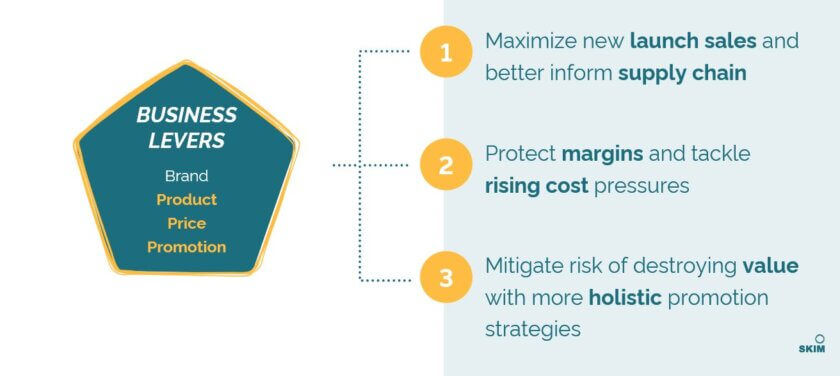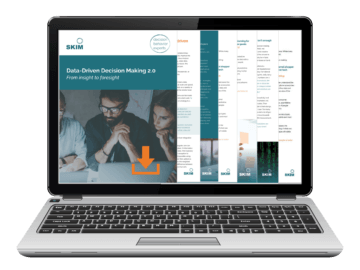Challenges and opportunities for data-driven decision making today
The shift towards data-driven strategies has been fueled by the digital-first economy, the proliferation of data and AI. Global spending on big data analytics technology and services was $180 billion in 2019, growing at a rate of 12% each year. At the same time, businesses continue to strive for faster, more holistic and more reliable decision making.
However, to tackle today’s and tomorrow’s business challenges with the best possible outcomes, companies must consider carefully how they integrate hybrid information and data sources.
The next era of data-driven decision making will be born out of new ways of analyzing information and data, plus new ways of activating the results.
To better understand where companies stand in their quest for data-driven decisions, we interviewed some SKIM clients, information experts and thought leaders in the industry.
“We have models to offer clients the right product, at the right moment, with the right tone of voice, for the right price.”
Companies that can effectively adapt to these changes will make data-driven business strategies a reality. They will be the ones that enjoy a competitive edge and achieve growth in today’s ever-changing market.
Selecting the right analytics approach for more holistic data-driven decisions
Regardless of industry, most companies today recognize the potential value hidden within different data and information sources. They see potential for more holistic decisions and more accurate predictions.
However, each organization is on a different journey towards realizing that reality – true data-driven decision making across the organization. Each one faces distinct challenges and goes about achieving this differently depending on where they are on this ‘data’ path. 
Although sources may be scattered throughout your company, better predictions can only be made by combining these sources with the best analytical approach.
There are three ways companies can combine data and information sources, depending on the type and nature of the business issues at hand:
1. Data triangulation (conceptual)
Triangulating hybrid data and information sources allows companies to assess them together.
“Sources do not have to be technically linked. The ease of use, the accessibility, is more important than technical integration.”
The integration is not done technically, but conceptually. For some clients this approach brings immediate value.
2. Data integration (technical data fusion)
Integrating data sources can quantify relationships between various datasets and especially improve the reliability and accuracy of predictions. Since historic and predictive data are combined (e.g., sales data, distribution data plus conjoint data), by nature, this approach provides a more complete picture. Continuously integrating data sources means data sources are connected and modeled at scale and speed. As mentioned by one client:
“And this, is the holy grail.”
Predictions are based on new data feeds on a weekly or even daily basis, by channel or even at the retailer level. With this approach, data-driven decisions can be made faster and more accurately.

What “data-driven decision making” looks like in action
Regardless of industry, all companies recognize the growth potential of unlocking the value of these fragmented data and information sources. However, how each company goes about achieving this differs significantly. Each company sets out on a different journey to realize true data-driven decision making. Depending on where they are that journey data-driven decisions will take different forms with different business benefits.
Uncover growth opportunities for consumer goods products and services
Integrating data sources to improve pricing strategies
Pricing and insights professionals are well aware of the complexity surrounding revenue management strategies. Nothing happens in isolation. How do you determine which business levers – brand, product, price, promotion – to use and when, in order to maximize growth?

When making these decisions, it’s also important to consider your competitors, current conditions in the industry, the various channels and consumers.
In our Holistic pricing decisions webinar, our NRM and pricing practice lead shares real-world examples of how companies are using data-fusion research techniques to improve revenue management strategies.
Improve product forecasting accuracy in pharma and consumer health markets
Integrating HCP and patient/consumer perspectives for more reliable predictions
The decision-making process for healthcare treatments and OTC products is more complex than ever. For pharmaceutical products, HCPs are no longer the only decision-maker for healthcare treatments. In some cases, the empowered patient can even challenge physician recommendations. In the consumer health space, marketers are tackling the increasing influence HCPs are having on OTC purchases, from infant formula to vitamins.

To more accurately predict treatment and purchase decisions. forecasting research should go beyond one perspective. The model should match the reality of today’s decision behavior
Register for the Decision influence modeling webinar to learn more about a new data-fusion analytics approach which integrates the relevant mix of HCP and patient/consumer decision behavior.
PepsiCo builds a more effective promo strategy
 If your company runs promotions, you must be asking the piercing question: what is the best promo strategy?
If your company runs promotions, you must be asking the piercing question: what is the best promo strategy?
Such was the challenge PepsiCo Benelux faced with its savory snacks, nuts and cereals categories, all of which are under constant pressure from competition.
PepsiCo needed to optimize its promotions strategy with sustainable impact on sales and revenue growth. To define this strategy, SKIM analyzed 3 years of sales data to determine the long-term impact of promotions.
We combined this historical analysis, with a conjoint study to test new promotions. Integrating both data sources led to valuable insights including the short- and long-term impact of promotions,
“Our plans for next year and beyond will now be better following shopper behavior and we can really build a long-term promotion strategy.”
Heineken and McDonald’s adopt holistic pricing mindset
 You know solid revenue decisions should be grounded in sound data, but that input often comes from a variety of sources and stakeholders.
You know solid revenue decisions should be grounded in sound data, but that input often comes from a variety of sources and stakeholders.
While consumer price elasticity insights may suggest one course of action, brand tracker data, historical sales figures or even management’s “gut feel” can often derail your pricing decision. How you apply these various inputs can affect the success – or failure – of a single pricing decision on your bottom line.
So, how can you best leverage all company data in a more holistic way to increase revenue and profitability?
Heineken’s Revenue Management Lead for Africa, Middle East, and Eastern Europe, Jorge Roberto Salas Samamé sums it up:
“Combining macro indicators, consumer/shopper insights, price sensitivity, brand health indicators, customer strategies, financials and overall market trends enables holistic pricing decisions”
Companies, like Heineken and McDonald’s, are doing this exceptionally well today and are reaping the returns. They’ve embraced a new holistic pricing mindset, and have turned to SKIM to help enable this shift.
Chivas identifies priorities for whisky launch
 Pernod Ricard-owned Chivas Brothers needed robust data to help build confidence internally and secure marketing budget around the launch of a new whisky in the Australian market.
Pernod Ricard-owned Chivas Brothers needed robust data to help build confidence internally and secure marketing budget around the launch of a new whisky in the Australian market.
The company turned to SKIM to combine sales data with research data for a more accurate prediction of how many cases would be sold each week for three years after launch.
We integrated the share of preference from the conjoint simulator, with the seasonality and distribution effect from the sales-data analysis. The result was a volumetric model which forecasted the brand’s potential success and highlighted marketing priorities.
The company was able to combine output from the SKIM predictive simulator with other aspects of the research to illustrate what would impact different price choices, distribution and marketing activity could have on sales and positioning.
Learn more about the data-fusion insight approach Chivas leveraged to distill data
A fun, holistic approach to driving agile decisions
 Holistic, data-driven decision making is more complex than ever before, thanks to siloed data sources, competing stakeholder concerns and perspectives and the need to make decisions quickly in response to changing markets and priorities. These realities can impede your ability to make the best decisions to achieve your company’s goals. However, some of our clients are adopting a fun, holistic approach to drive agile decision making: business wargaming.
Holistic, data-driven decision making is more complex than ever before, thanks to siloed data sources, competing stakeholder concerns and perspectives and the need to make decisions quickly in response to changing markets and priorities. These realities can impede your ability to make the best decisions to achieve your company’s goals. However, some of our clients are adopting a fun, holistic approach to drive agile decision making: business wargaming.
These cross-functional interactive workshops stress-test your decisions. Business wargaming is a process that integrates both data and people to enable holistic and agile decisions.
Getting in your competitors’ shoes can be very revealing.
Participants solve a specific business issue by playing “what-if” scenarios in a competitive environment of actions and reactions.




